Is Education 4.0 an imperative for success of 4th Industrial Revolution?
Although the Fourth Industrial Revolution (4IR) was publicly announced in Davos in 2016, various elements related to what makes this new dimension has been ongoing for almost a decade. The term received wide publicity when German Chancellor Angela Merkel highlighted at the Hanover Fair in 2011, the emergence of Industry 4.0 to make German manufacturing more competitive.
Emergence of Industry Revolution 4.0
Industry 1.0: (1784) : Based on mechanical production equipment driven by water and steam power.
Industry 2.0: (1870): Based on mass production enabled by the division of labor and the use of electrical energy.
Industry 3.0 (1969): Based on the use of electronics and IT to further automate production.
Industry 4.0 (today): Based on the use of cyber-physical systems.
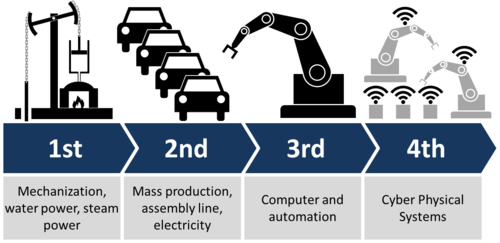
The reason to say that the fourth industrial revolution is in full force today is due to the fact that velocity and impact of current breakthroughs is like never before. The innovations and advances are omnipresent led by strong emergence of fields like Artificial Intelligence, Robotics, Internet of Things, Autonomous Vehicles, Biotechnology, Nanotechnology, 3-D Printing, Material Science, Quantum Computing and Energy Storage. The impact of such breakthroughs is so rapid that the fourth industrial revolution is evolving at an exponential pace, and disrupting almost every industry.
Opportunities brought by Fourth Industry Revolution
Industry 4.0 can play a vital role in raising the global income levels and take our current stand of living to a next orbit. Technology has made it possible to make products and services that enable us to lead a better life. This will drive gains within the efficiency and productivity of our current lifestyle, leading to:
- Increase in global income levels
- Enhanced quality of life with higher order technologies
- Reduction in transportation and communication costs
- Creation of new products and markets
- Safer workplace as hazardous work is taken over by robots
- Enhanced health services leading to longevity
Challenges of Fourth Industrial Revolution
On the contrary, one of the biggest challenges is that it could lead to even higher inequality, as emerging technologies take over labour intensive jobs. But, then Economist Eric Brynjolfsson has famously said, “Technology has always been destroying jobs, and it has always been creating jobs.” Apart from this, the other challenges could be:
- Security issues of data and maintaining privacy
- Risk of greater inequality in labour markets
- Decrease in real income of workers as machines take over
- Displacement of workers by machines and artificial intelligence
- Creation of higher order human jobs is always a concern when automated technologies takeover day to day jobs
The Six Drivers of Change in workplace brought by Fourth Industrial Revolution
The Fourth Industry Revolution with its opportunities and challenges will bring to the forth the new drivers of change in workplace and organizations. These are summarized in the info-graphic below:
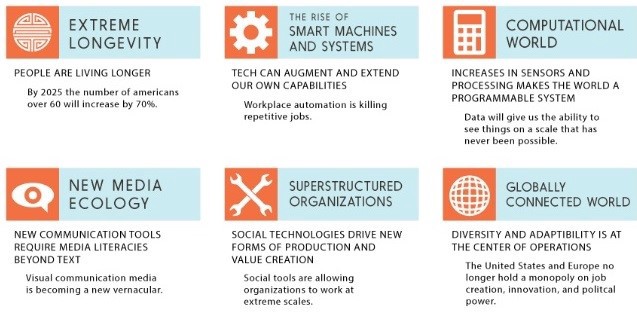
The Skills of Tomorrow needed in the 4IR world
With the drivers of change as enumerated above, the skill-set that would be required by the “jobs- of –the- future” would change rapidly. Some of these skills are specified in the following info-graph.
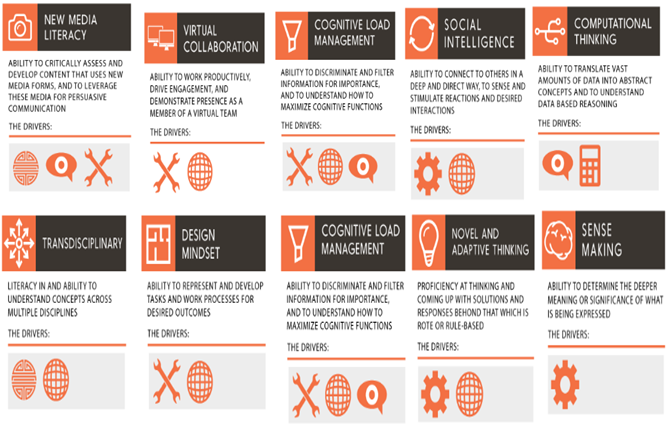
The points to ponder here is whether our education framework today can lead to development of such skills, which will also meet the aspiration of our Generation ‘Z’, who will cut their teeth in 4IR world.
Aspirations of Gen Z
Gen Z is defined as teenagers ages between 13 to 19 currently. They are growing up in a time so revolutionized by technology that it hardly resembles that of their parents and grandparents. This is the generation that would be attending colleges in the coming years!!

In a recent survey conducted among this generation, three notable aspirations came out strongly; about 22% of them expressed desire of relevant and meaningful education to equip them for jobs of the future; about 38% wanted strong growth early enough in their careers and another 32% wished most of their dreams to be fulfilled within 10 years of their entering the new age exciting career.
Changed Habits of Gen Z
We now come to issues of how the current Generation Z has changed from those of the earlier generations in terms of reading and learning habits. The table below summarizes these changes:
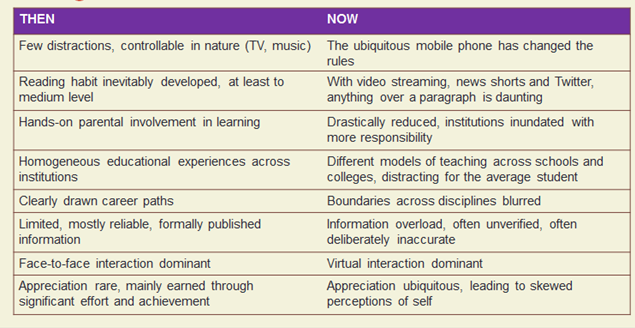
Need for Education 4.0 framework
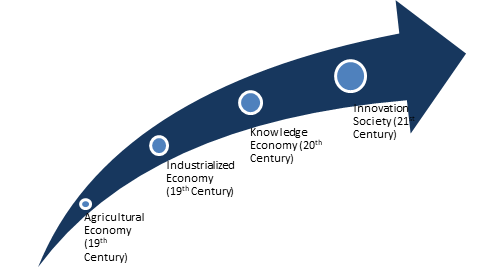
One of the imperatives of the 4IR is human capital enhancements to be able to meet the knowledge and skills requirements. This, as we saw in previous section, puts demand on knowledge production and innovation applications of knowledge. Also, changes in reading and learning habits need that educationalists devise new pedagogical techniques. The rapid pace of emergence of Industry 4.0 requires that Education 4.0 also leapfrogs from the current Education 2.0 framework to Education 3.0/4.0.
Education 1.0: centuries of experience with memorization
Education 2.0: Internet-enabled learning
Education 3.0: Consuming & Producing knowledge
Education 4.0: Empowering education to produce innovation
Evolution of Education 4.0
Following tabular representation depicts the stages of evolution of education over the years. This construct shows how things have changed from education 1.0 to the emerging education 4.0 paradigm.
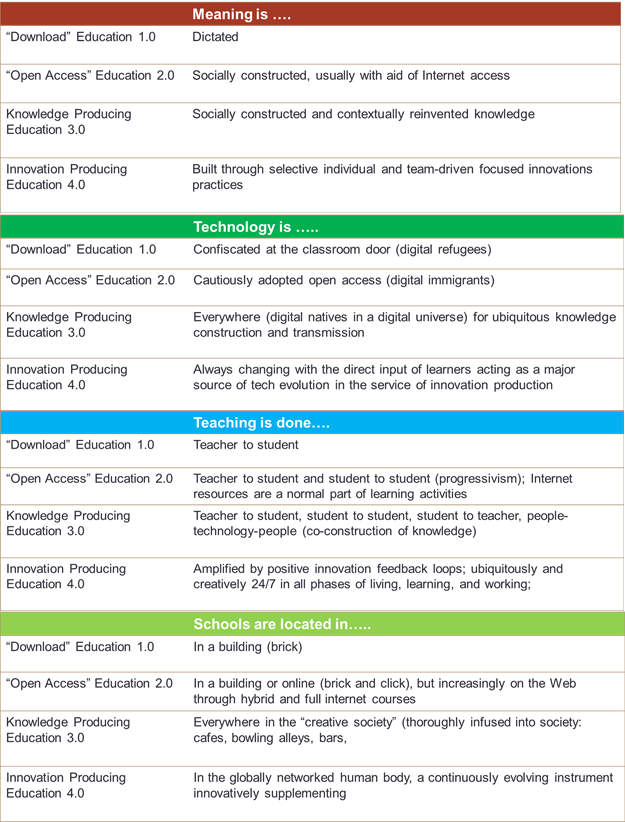
5 I’s of Learning in Education 4.0
A learning framework is presented below which is aligned to changed habit of Gen ‘Z’ and need for an innovation producing education.
- IMBIBING: Internalizing basic concepts
- ITERATING: Practicing fundamental skills rigorously
- INTERPRETING : Taking facts from study and applying them to different situations with adaptive alterations
- INTEREST: Developing enough curiosity about a subject so as to delve deep and create further body of knowledge
- INNOVATING: Think differently and come up with original concepts and build innovative ideas, products and services
Building the I’s in Education 4.0
Now, let us briefly dwell on how the various facets of the learning model will operate.
Imbibe— from different sources
- Boredom sets in easily for today’s students, there need to infuse excitement from visual and aural inputs
- Use multiple sources — the Internet is your best friend, films, experiences
- Change source material year after year keeping the curriculum at the leading edge.
Iterate— through fun
- Gamify tests — run them as competitions
- Subject championships as teams, evaluated through the year
- Redefine assignments — as challenges where more and more elements of knowledge can be synthesized.
Interpret
- Form student teams and give open-ended projects involving sports or other avenues. For example, while teaching Economics basics, let students do a project on valuation models for football or Kabaddi players.
Interest
- Cover one part of a concept in class, get a group of students to deliver the remaining part. Different group for each concept. This removes stage fright and makes them willing participants too.
Innovate
- Go cross-discipline. Groups of teachers amalgamate subjects to craft year-long projects with a presentation month.
Building Undergraduate program in context of E4.0 and 4IR
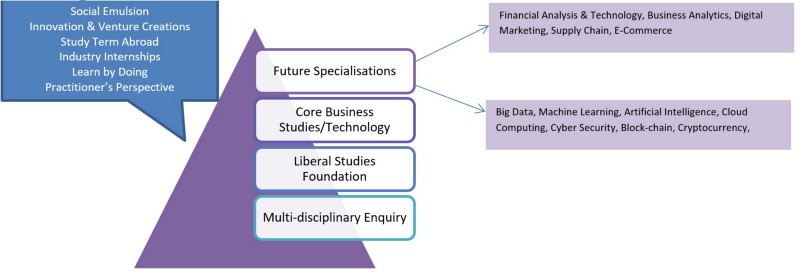
Programs designed to produce Professional Triathletes who can excel in many dimensions that would be needed for the workforce of 4IR
- Core of Business or Technology Discipline
- Specializations for careers of tomorrow
- Digital Marketing, Business Analytics, Machine Learning & AI, Internet-of-Things, Financial Technologies, etc.
- Liberal Dose of Liberal Studies
A truly well-rounded personality building experience — courses on Literature, Performing & Visual Arts, Public Policy, Psychology, Sociology, Media, Design
- Learning by Doing
- Social Sector Internships, Study-Abroad Terms, Industry Engagement
Pedagogical Approach in world of E4.0
From rote to rigor : Not remembering the right answers, it’s about figuring out the right questions
- It’s not about YOU: Emotional Intelligence supersedes individual brilliance. Learn in teams, grow as teams.
- Creators shall inherit the Future: Schools and institutions must pledge NEVER to shoot down ideas. Foster creativity by open-ended questions that take greater time to evaluate but lead to true thinking and real innovations
No token or token has expired.
Deprecated: Function get_magic_quotes_gpc() is deprecated in /home1/silvege7/public_html/paradigmconsultant.com/wp-includes/formatting.php on line 4371
